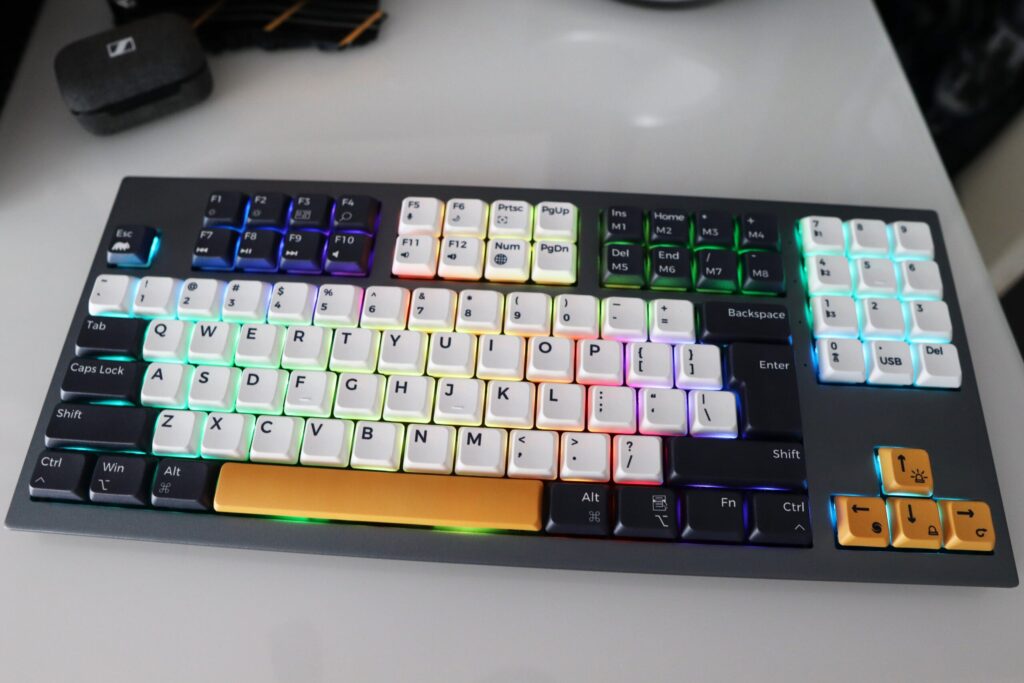Verdict
The Wombat Willow is an intriguing low-profile mechanical keyboard with an interesting layout that offers convenient wireless connectivity, a snappy typing experience and solid construction. Just watch out for its hollow acoustics and meagre software.
Pros
- Unique layout
- Snappy switches
- Solid wireless connectivity
Cons
- Hollow acoustics
- Basic software and lighting
-
Gateron LP Red switches:The Willow Pro comes with light and linear, low profile Gateron LP Red switches inside. -
Unique layout:It also comes with a interesting space-saving layout that we’ve never seen before. -
Bluetooth & 2.4GHz wireless connectivity:The Willow Pro can also connect wirelessly via Bluetooth and its included 2.4GHz USB-A receiver.
Introduction
The Wombat Willow Pro is a rarity in the mechanical keyboard space, offering an intriguing key layout that I’ve never seen before.
As an enthusiast of all things mechanical, I’ve seen keyboards come in all shapes and sizes, with smaller 65 percent options all the way to more conventional full-size pieces, and Wombat’s new option takes the layout rulebook and rips it up.
In addition, this is also a wireless low profile option for both Windows and macOS that ticks a lot of the right boxes for a keyboard at its respectable $144.99 price tag. With that, it’s in the same ballpark as some of our favourites in recent months and years, the Lofree Flow, NuPhy Air75 V2 and the Logitech MX Mechanical Mini.
I’ve been testing the Willow Pro for the last few weeks to see how well it performs, and as to whether it makes for one of the best mechanical keyboards we’ve tested.
Design
- Smart, grey chassis
- Intriguing layout
- Thoughtful interface and keycap construction
The Willow Pro is certainly a smart keyboard by way of looks with a two-tone grey and predominantly white set of PBT keycaps, although some accent keys are black with others in yellow. It fits well in my predominantly grey and black office, while looking at home in funkier decorated spaces.
The combination of a majorly plastic chassis with a grey metal top plate for extra rigidity pays dividends here, as the Willow Pro feels great. It tips the scales at 1kg, which is pretty hefty for a low-profile keyboard with a smaller chassis, making it perhaps unsurprising that there’s no deck flex whatsoever, even under pressure.

The big thing with this keyboard is its layout, which is, in a word, weird. On first inspection, it looks like a TKL layout with arrow keys in the bottom right corner in their own cluster, although look closer and you’ll see that it’s completely different from any other keyboard around. Firstly, where the nav cluster would be, there’s a dedicated number pad. Across the top, there are 24 other keys, grouped in three lots of eight to give you the usual functions of an F-row, the nav cluster, and other handy keys, in one convenient space.
It takes a bit of getting used to, especially the number pad in the top right corner, but is a seriously powerful layout for productivity. That’s because you’ve got most, if not all, of the keys you need on a full-size keyboard, but in a much more compact form factor. It takes the gains found in an 1800, or 96%, layout, and takes it even further.


What’s also pleasant about the Willow Pro is the attention to detail here, with doubleshot PBT keycaps adding some extra quality, as well as those keycaps having both Windows and macOS functions on them. In addition, controlling the angle of the keyboard is easy as the feet on the bottom are magnetic, and can easily be flipped around to attach to the base of the Willow Pro to raise it up. The left hand side is also home to a small space for keeping the Willow Pro’s USB-A receiver.
The interface on the rear of the keyboard is similar to that found on Keychron keyboards, with a USB-C port for charging and wired operation, as well as an on/off switch and a selector switch between Windows and macOS. In spite of this keyboard working over both Bluetooth and 2.4GHz wireless though, there isn’t a toggle switch for choosing between which method of wireless connection you wish to use.
Performance
- Light, but inconsistent, switches
- Solid wireless connectivity
- Meagre battery life with RGB on
Inside, the Willow Pro makes use of Gateron’s low-profile LP Red switches. These are a 50g linear switch which offers a snappy actuation with no tactile bump or audible click and are reasonably comfortable to type on.
Against the likes of the Phantom switches found in the Lofree Flow, or the MX Low Profile Reds found in the Cherry MX LP 2.1 Compact Wireless, the Gateron LP Reds feel a little hollow and inconsistent.
They’re perfectly fine for the productivity tasks that the Willow Pro is intended for, and if you want to swap them out, this ‘board is hot-swappable. In addition, the decision for Wombat to use a plastic bottom casing means this keyboard also sounds quite hollow in terms of its acoustics. Options from Lofree and NuPhy are stronger in the aural department, too, at least with these switches inside the Willow Pro. There is a silent switch variant if you’d prefer a quieter choice, though.


Wireless connectivity is handled with either Bluetooth or 2.4GHz, with plug-and-play means over both methods. What’s also handy is that the Willow Pro comes with a USB-A to USB-C adapter for using the keyboard with modern Macs that lack a USB-A port without any issues. In testing the keyboard with both my main Windows gaming PC and 2021 MacBook Pro, the Willow Pro worked without a hitch on both devices.
Wombat says the Willow Pro comes with a 1000mAh battery inside, which is half the capacity of the cell found inside the Lofree Flow. The only figure provided is up to four months with no RGB on, which is reasonable, although if you turn on the Willow Pro’s RGB lighting, in my experience the keyboard lasts for around 10 hours before needing to be recharged.
Software and Lighting
- Basic software offers okay customisation
- Bright RGB lighting
The Willow Pro utilises Wombat’s own Pouch software, which provides useful functionality for reassigning the keyboard’s function keys, programming macros and for fiddling with the RGB lighting. There are a range of different preset effects to choose from, with a sum total of 13, alongside more advanced means, too. It isn’t as slick as software tools from larger manufacturers in look and feel, and lacks the extensive functionality that VIA offers with other enthusiast-level keyboards. For basic customisation such as programming keys, it’s completely fine, although is at least stronger on its RGB lighting options.


It’s much the same story for the Willow Pro’s lighting. It offers a full spectrum of RGB with bright and vivid lighting beneath the keys, although lacks the more advanced effects found on boards from bigger brands.
Latest deals
Should you buy it?
You want a unique layout
The Willow Pro offers a seriously interesting layout that combines the functionality of a full-size keyboard with a smaller form factor with little sacrifice. If this type of layout is appealing, then this is the keyboard for you.
You want more advanced software
The Willow Pro offers an intriguing layout, but falls short with its software that only offers basic customisation of lighting and key remapping. A lot of the competition comes with much more advanced software integration.
Final Thoughts
The Wombat Willow Pro makes for one of the more interesting and unique keyboards we’ve tested, with a layout that offers the benefit of a lot of keys in a much smaller space with a sensible arrangement. This isn’t a layout I’ve ever come across before, but it’s one that sets the Willow Pro apart from the competition.
Combined with this, it also gets a lot of the basics right with a sturdy metal and plastic frame, as well as decent low profile switches and solid options for wireless connectivity. It also looks the part with a professional grey and black scheme, with the accented yellow keycaps welcome flair.
It’s on the front of the software where the Willow Pro falls down against similarly-priced productivity-focused choices such as the Logitech MX Mechanical Mini, while its acoustics and switch feeling aren’t quite as good as the Lofree Flow. The Wombat Willow Pro is a decent low profile keyboard, although there are better options available for its higher price tag. For more options, check out our list of the best mechanical keyboards we’ve tested.
How we test
We use every keyboard we test for at least a week. During that time, we’ll check it for ease of use and put it through its paces by playing a variety of different genres, including FPS, strategy and MOBAs.
We also check each keyboard’s software to see how easy it is to customise and set up.
Spent at least a week testing
Tested the performance on a variety of games
Compared the build quality with similar priced keyboards
FAQs
The Wombat Willow Pro connects either via Bluetooth or 2.4GHz over wireless means, working with Windows and macOS.
The Wombat Willow Pro offers a unique layout, packing a 96% or nearly full-size keyboard into a TKL-sized chassis.
Trusted Reviews test data
Battery discharge after 1 hour of gaming
›
USA RRP
Size (Dimensions)
Weight
Release Date
First Reviewed Date
Ports
Connectivity
Switch Type
Number of Macro Keys
Cable Length
Battery Length
›


